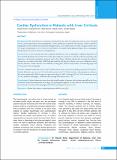Please use this identifier to cite or link to this item:
https://hdl.handle.net/20.500.14356/1413| Title: | Cardiac Dysfunction in Patients with Liver Cirrhosis |
| Authors: | Karki, Niyanta KC, Sudhamshu Sharma, Dilip Jaisi, Bikash Khadka, Sandip |
| Citation: | KarkiN., KCS., SharmaD., JaisiB., & KhadkaS. (2019). Cardiac Dysfunction in Patients with Liver Cirrhosis. Journal of Nepal Health Research Council, 17(3), 357-361. https://doi.org/10.33314/jnhrc.v17i3.1969 |
| Issue Date: | 2019 |
| Publisher: | Nepal Health Research Council |
| Article Type: | Original Article |
| Keywords: | Chronic liver disease Cardiac dysfunction MELD score QTc |
| Series/Report no.: | July-Sep, 2019;1969 |
| Abstract: | Abstract Background: The clinical picture in cirrhosis is dominated by the classical complications such as ascites, bleeding varices, portal hypertension and encephalopathy. Cardiac dysfunction in patients with cirrhosis, which contributes significantly to the morbidity and, mortality though prevalent, is less studied and not widely recognized entity since it is largely asymptomatic at rest, with overt heart failure seen mainly during pharmacological stress, transjugular intrahepatic portosystemic shunt, liver transplantation. Methods: It is a cross sectional study done on patients admitted in wards or attending to outpatient department of Liver unit, Bir Hospital, between May 2015 to May 2016. Diagnosis of cirrhosis was based on clinical examination, lab parameters, ultrasound examination, endoscopy and/or liver biopsy. Cirrhotic patients after assessing the exclusion criteria were recruited for the study. Child Pugh and model for end stage liver disease scores were calculated to assess the liver function. Cardiac function was evaluated by resting pulse, mean arterial pressure, electrocardiography, and 2 dimensional echocardiography. Results: Diastolic dysfunction was seen in 61.9%(48) and was more common in alcoholic group (63.2% Vs 58.6%). Systolic dysfunction was seen in 6.6% of alcoholic patients only. 51.4% had cirrhotic cardiomyopathy according to the criteria (proposed by World congress of gastroenterology in 2005). Prolonged QTc of >0.44 seconds was noted in 79%, mainly in child pugh C, with model for end stage liver disease score >10. Conclusions: Cardiac dysfunction is prevalent with sizeable number of patients with cirrhosis especially in the form of diastolic dysfunction independent of etiology. QTc prolongation might be an early indicator of cardiac dysfunction and is directly correlated with child pugh and model for end stage liver disease scores. Keywords: Chronic liver disease; cardiac dysfunction; MELD score; QTc. |
| Description: | Original Article |
| URI: | http://103.69.126.140:8080/handle/20.500.14356/1413 |
| ISSN: | Print ISSN: 1727-5482; Online ISSN: 1999-6217 |
| Appears in Collections: | Vol. 17 No. 3 Issue 44 Jul-Sep 2019 |
Files in This Item:
| File | Description | Size | Format | |
|---|---|---|---|---|
| 1969-Manuscript-12210-1-10-20191114.pdf | Fulltext Download | 349.69 kB | Adobe PDF |  View/Open |
Items in DSpace are protected by copyright, with all rights reserved, unless otherwise indicated.
